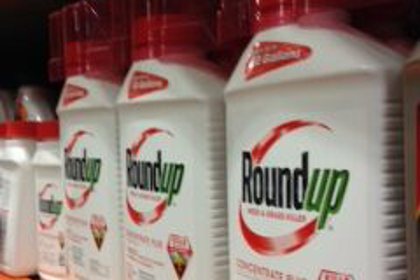
Glyphosate Herbicides Cause Tragic Phosphorus Poisoning of Lake Erie
A new study by experts from Ohio Northern University in the U.S. has shown that glyphosate herbicides are a main cause of the tragic phosphorus poisoning of Lake Erie.
The study follows a joint agreement by the U.S. and Canadian governments earlier in 2016 to seek a 40% reduction in phosphorus runoff into sections of Lake Erie plagued by harmful algae blooms that foul drinking water and kill fish.
Low soil pH and certain metals are causing glyphosate to release phosphorus from the soil, which is responsible for about 25% of dissolved reactive phosphorus runoff in the Maumee watershed.
Scientists now know that the increase in dissolved reactive phosphorus (DRP) runoff that’s been plaguing the western Lake Erie basin is mostly coming from farms located in the Maumee watershed.
But the question they’re still trying to answer is — why?
July 4, 2016 | Source: Sustainable Pulse | by
A new study by experts from Ohio Northern University in the U.S. has shown that glyphosate herbicides are a main cause of the tragic phosphorus poisoning of Lake Erie.
The study follows a joint agreement by the U.S. and Canadian governments earlier in 2016 to seek a 40% reduction in phosphorus runoff into sections of Lake Erie plagued by harmful algae blooms that foul drinking water and kill fish.
Low soil pH and certain metals are causing glyphosate to release phosphorus from the soil, which is responsible for about 25% of dissolved reactive phosphorus runoff in the Maumee watershed.
Scientists now know that the increase in dissolved reactive phosphorus (DRP) runoff that’s been plaguing the western Lake Erie basin is mostly coming from farms located in the Maumee watershed.
But the question they’re still trying to answer is — why?
Christopher Spiese, a chemist at Ohio Northern University, says a combination of factors is causing the problem. But at the Conservation Tillage and Technology Conference held earlier this year in Ada, Ohio, he focused in on one specific practice that’s changed over the last few decades — the use of glyphosate.
Coincidence or Causation?
Lake Erie’s troubles with phosphorus (P) aren’t new. In fact, the U.S. and Canada have been trying to clean up the amount of P in the lake for more than 40 years now, as the two governments created the Great Lakes Water Quality agreement in 1972 to focus on reducing the amount of P in the Great Lakes.
Since then, total P in Lake Erie has decreased significantly, Spiese says. DRP loads were also coming down, but started increasing in the mid 1990s.
At that same time, glyphosate use took off with the advent of herbicide-tolerant crops. As of 2014, Spiese says, more than 95% of soybeans and over half of corn in the U.S. are Roundup Ready, and those percentages probably haven’t changed over the last 2 years.
“These crops that are able to grow in the presence of glyphosate have really kind of started to take over, to the point where we’re washed in Roundup,” he says.
So Spiese and his team at Ohio Northern University decided to see if the correlation between the increased use of glyphosate (Roundup) and increased DRP loads in Lake Erie were related.
Roundup’s Role
To determine if glyphosate is a contributor to DRP runoff, Spiese says three things have to be true:
- The amount of DRP is related to the amount of herbicide-tolerant crop acres in the Maumee watershed.
- Glyphosate is able to release P by a plausible mechanism.
- The quantity of P released must be a substantial portion of the P increase.
Spiese looked at the first statement and found there is a significant correlation between DRP loads and the number of acres growing herbicide-tolerant crops, counting for about 30% variability in the DRP loading.
“For every acre of Roundup Ready soybeans and corn that you plant, it works out to be about one-third of a pound of P coming down the Maumee,” he says.
